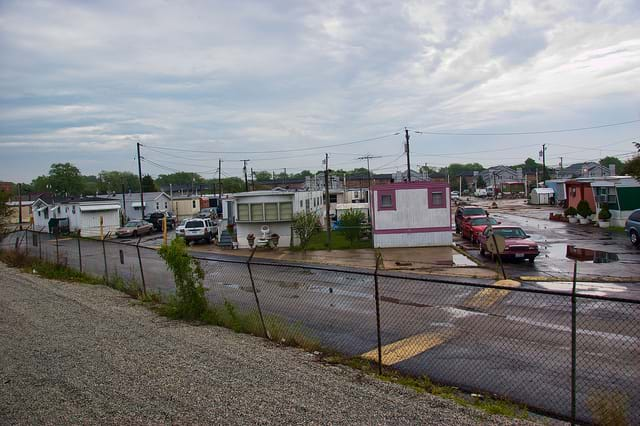
This post originally appeared on TalkPoverty.org.
It was one of those arresting moments that transfixed the room: Amy, a military veteran and divorced mother, stood up at the mic and choked back tears as she told her story. She had gone to school to become an elementary school teacher, but wasn’t able to find full time work. With two kids to support, she was earning just $15,184 a year, far below the poverty line for her family. But she was one of the lucky ones for whom there was a lifeline: after obtaining Medicaid and Section 8 housing, Amy was admitted into a program at her local community action agency in her home state of Wisconsin that helped cover the costs of returning to school. Amy is now a reading specialist with a full time stable job and benefits and owns her own home.
The people listening to Amy’s story were journalists. They were part of an unusual event organized by NBC News, my former employer, that brought journalists and anti-poverty advocates together to do something they don’t do very often: talk to one another. Inspired by open-mic poetry slams, this was called a “poverty pitch slam.’ The pitch slam was part of the NBC News “In Plain Sight: Poverty in America’ project, a special reporting initiative supported by the Ford Foundation, which I launched and ran in 2013 (the project, which recently won a George Foster Peabody award, is now in its second year, and—full disclosure—I have transitioned to a new job as program officer in the Ford Foundation’s Media & Justice initiative).
Amy was one of a dozen people who had five minutes or less to pitch their stories to the panel of journalists from around the nation, including reporters and editors from big platforms like USA Today and NBC News, as well as smaller outlets like public radio stations and the Springfield News-Leader in the Ozarks (whose Every Child project has been brilliant and powerful).
The pitch slam coincided with the 50th anniversary of the launch of President Johnson’s “war on poverty,’ which generated a flurry of big-media press coverage of poverty, an issue, as Dan Froomkin pointed out last year in an essay for Nieman Reports, that the “mainstream’ media tend to mostly ignore. (A finding corroborated by Fairness and Accuracy in Reporting (FAIR), in a new study of the three major network evening newscasts set to be released next month.) On the January anniversary of LBJ’s speech, however, the Washington Post, for example, presented everything we presumably need to know about the war on poverty, and The New York Times judged the war on poverty a “mixed bag.’ Most of the coverage binge, as FAIR’s radio program, “Counterspin,’ pointed out, focused on either methodology—how we count poverty and whether it has gone up or down over the last half-century—or on the deep political and philosophical divide that exists over how to attack poverty in this country. What it didn’t really focus on was the people, like Amy, who can tell the very real stories of what it is like to be poor, and to want to be not-poor, and how hard it is in America 50 years after LBJ’s speech to do what he pledged: to replace despair with opportunity.
But these are the stories that are out there to be told, begging to be told, and I am here to tell you that, contrary to the beliefs and fears of editors and executive producers, these are deeply personal stories that, when told, do captivate the audience of readers, listeners, and viewers.
In the first year of the NBC News In Plain Sight project, the coverage (most of it online) included stories about life on minimum wage, fast food worker strikes, hunger, urban and suburban poverty, childhood asthma in poor urban areas, homeless veterans, the “unbanked,’ threats to food stamps, criminal debt, transportation for low-income workers, gays and poverty, the dental crisis for the poor, putting off parenthood for financial reasons, unemployed older workers, the disappearance of “the American dream’—and more—and viewers did not turn the channel or click away from the 100+ stories we presented. In fact, the sharing of stories via social media was robust.
So here are a few more story ideas that I didn’t get around to, but I hope somebody else will. (As Henny Youngman might have said had he been a journalist, take my story ideas…please!)
If you’re so poor…: When many Americans see food stamp recipients who are obese, or struggling families with flat-screen televisions, they wonder how this can happen; same thing when they see a poor kid in an expensive pair of sneakers. Brian Charles, a reporter on the poverty beat in Connecticut, talks about “death by a thousand ‘no’s’.’ As he explains it, what people don’t see when they see that kid in the Nikes is that the kid’s mom may have said no so many times that finally, when the kid wanted those sneakers, for once, that thousandth time, she said yes. Tell the story of those moms, and those kids. Explain how flat-screens are cheap but good schools and real opportunity are not. Explain the link between scarcity and obesity. And tell the stories through the experience of the real experts, the people who live them, by connecting with organizations like Witnesses to Hunger.
Welfare-to-work: Has it worked? It’s been nearly 20 years since President Clinton enacted “welfare reform’ into law. The new law definitely did end “welfare as we know it,’ but did it come through on its promise to move millions of poor Americans to work that leads to good jobs? What is the truth about TANF? There’s some great policy work on this question, but let’s not forget about the human stories—the “success stories’ and the failures.
Solutions: Amy’s story is a story about programs that worked to lift her out of poverty. There are other stories like that out there, waiting to be told, and to be appreciated by an audience that wants more than doom and gloom. The Solutions Journalism Network has a lot of really smart stuff to say about how to do this kind of solutions-oriented reporting, and the HalfInTen story bank is a great resource for people who, like Amy, are willing and ready to tell their personal stories.
I know the people who are launching TalkPoverty.org well—Greg Kaufmann, from his work as a fellow poverty reporter when he was at The Nation, and the folks at the Center for American Progress through their ongoing poverty work. They are going to bring unique voices to this blog—from people doing cutting-edge work as researchers, advocates, and activists in the fight against poverty, to the people living in poverty themselves.
I hope reporters will keep up with this blog to discover story ideas and people they should talk to in covering poverty. There are way too many stories that still need to be told. It would be great if we could get to a point where poverty reporters had to worry about being scooped. We’re not there yet.
